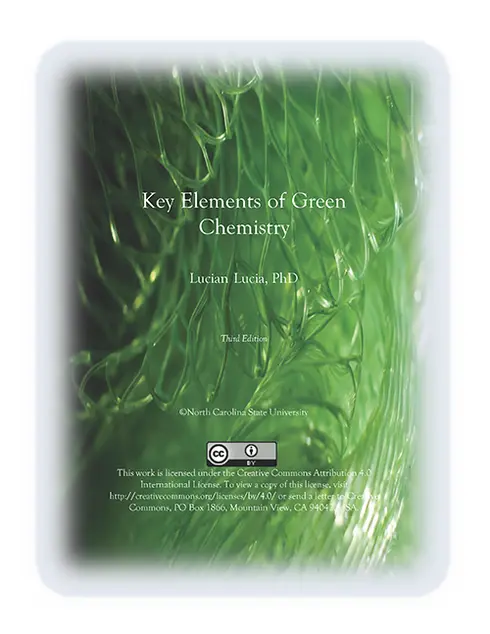
Key Elements of Green Chemistry
![]()
![]()
![]()
![]()
![]()
Lucian Lucia, North Carolina State University
Copyright Year:
Publisher: A.T. Still University
Language: English
Formats Available
Conditions of Use
![]() Attribution
Attribution
CC BY
Reviews
Reviewed by Debasish Bandyopadhyay, Assistant Professor, University of Texas Rio Grande Valley on 12/22/21
The book presents the major concepts of green chemistry in six chapters. read more
![]()
![]()
![]()
![]()
![]()
Reviewed by Debasish Bandyopadhyay, Assistant Professor, University of Texas Rio Grande Valley on 12/22/21
Comprehensiveness
The book presents the major concepts of green chemistry in six chapters.
Content Accuracy
The content is accurate and to the point.
Relevance/Longevity
All the materials presented in this book are updated.
Clarity
The text is written in simple language that should be helpful for the readers to understand the topic.
Consistency
The six chapters are well-aligned, and the whole concept of green chemistry has been thoughtfully presented in this book.
Modularity
The text is easily and readily divisible into smaller reading sections that can be assigned at different points within the course. Under each chapter, there are several headings sections and subsections. The text is not overly self-referential and should be quickly reorganized and realigned with various subunits of a course without presenting much disruption to the reader.
Organization/Structure/Flow
In each chapter, their sections and sub-sections have been organized stepwise.
Interface
The text is free of significant interface issues, including navigation problems, distortion of images/charts, and any other display features that may distract or confuse the reader.
Grammatical Errors
There are no significant grammatical errors.
Cultural Relevance
The text is not culturally insensitive or offensive in any way.
CommentsAlthough the book's target readers are green chemists, it is an excellent reference book also for toxicologists, chemical engineers, pharmacologists, and biochemists. The author has successfully correlated the green chemistry parameters with the real world. For example, the author included the incidents of burning oil and debris that collected on the surface of the Cuyahoga River (Cleveland), the thalidomide issue etc. The discussion on the LCA software, the globally harmonized system (GHS) that attempts to categorize the general types of threats in society, specifically, is fascinating. The concept of different hazards such as carcinogens, mutagens, teratogens, tumor promoters, corrosives, neurotoxins, lachrymators has added special value to this book. The lethal dose of everyday things like water to Vit C provides real-world examples. The author has brilliantly correlated the chemistry world with the business world by the dual meaning of ‘solvent’. Discussion on alternative solvents like green biobased solvent methyl soyate, eutectic mixture, microemulsion, etc., are fascinating. Combinatorial chemistry and organic reaction mechanism part will undoubtedly draw attention to the organic chemistry students. In the last chapter, the classification of organic reactions and their correlation with green chemistry is eloquent. The images are significant. The author referenced each image so that curious readers could go more over it. At the end of each chapter, the review questions will insist the readers rethink the subject matter. A little comicalness throughout the book will keep the readers smiling.
Table of Contents
- Chapter 1: Principles Of Green Chemistry
- Chapter 2: Life-Cycle Analysis
- Chapter 3: Hazards
- Chapter 4: Alternative Solvents
- Chapter 5: Alternative Reagents
- Chapter 6: Reaction Types, Design, And Efficiency
- Index Of Terms
About the Book
Green chemistry, in addition to being a science, it is also a philosophy and nearly a religion. Attendance at American Chemical Society Green Chemistry & Engineering Conferences will instill such an ideal into any attendant because of the nearly universal appeal and possibilities in this novel approach to radicalizing the business of doing science and engineering.
About the Contributors
Author
Lucian Lucia currently serves as an Associate Professor in the Departments of Forest Biomaterials and Chemistry and as a faculty in the programs of Fiber & Polymer Science and Environmental Sciences at North Carolina State University. His laboratory, The Laboratory of Soft Materials & Green Chemistry, probes fundamental materials chemistry of biopolymers. He received his Ph.D. in organic chemistry from the University of Florida under Professor Kirk Schanze for modeling photoinduced charge separation states of novel Rhenium (I)-based organometallic ensembles as a first order approximation of photosynthesis. He began his professional career as an Assistant Professor at the Institute of Paper Science and Technology at the Georgia Institute of Technology examining the mechanism of singlet oxygen’s chemistry
with lignin & cellulose. A large part of his recent work has been focused on the chemical modification of cellulosics for biomedical applications. He teaches From Papyrus to Plasma Screens: Paper & Society (PSE 220), Principles of Green Chemistry (PSE / CH 335), and is the graduate supervisor for the Forest Biomaterials Seminar Series (WPS 590 / 790) while providing workshops in Wood Chemistry and Green Chemistry at Qilu University of Technology in PR China. He has co-founded and co-edits an open-access international research journal, BioResources, dedicated to original research articles, reviews, and editorials on the fundamental science & engineering and advanced applications of lignocellulosic materials.
